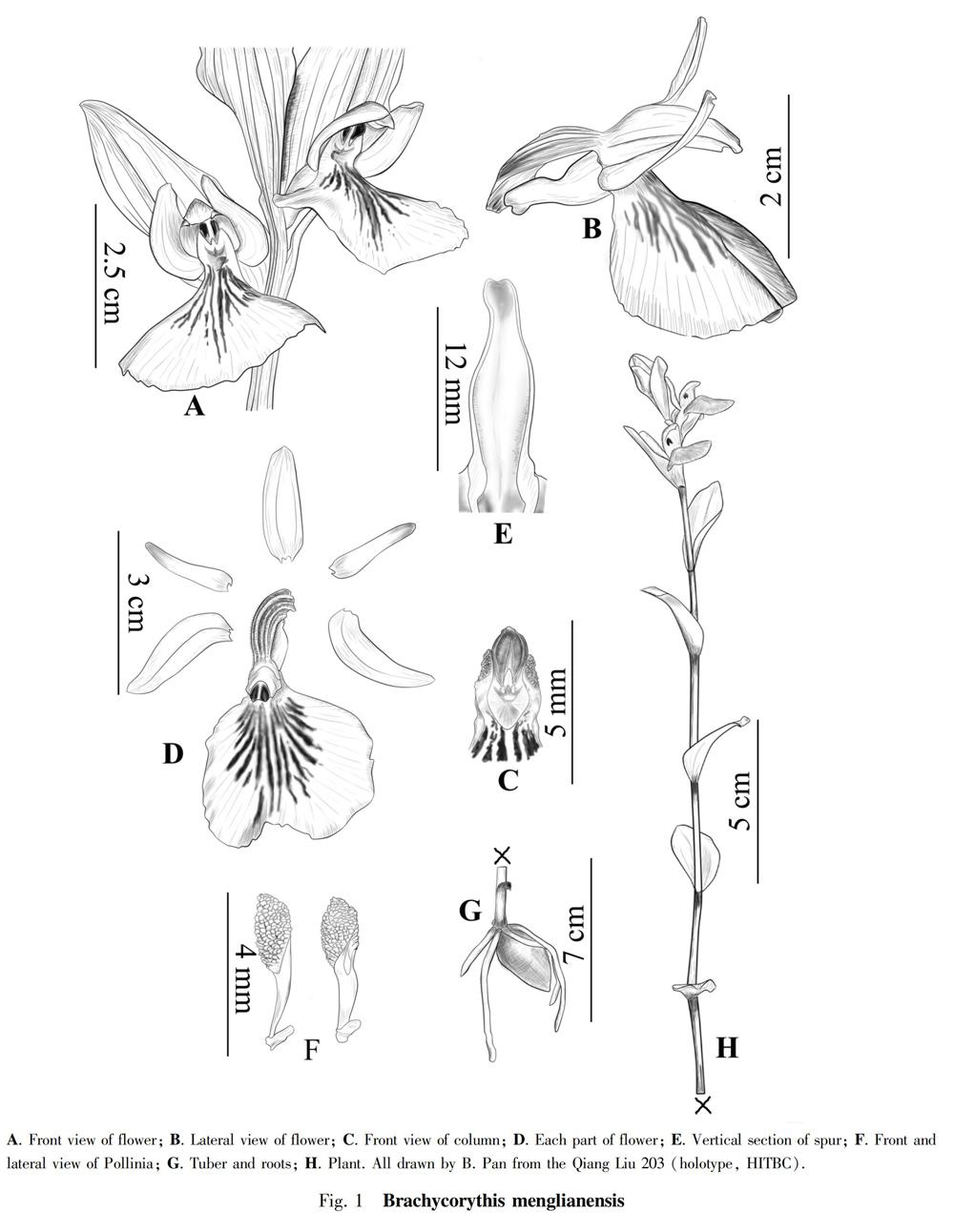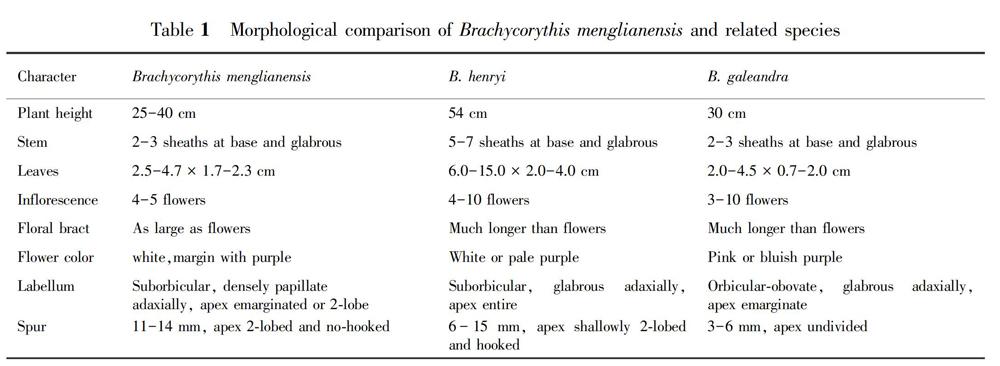孟连苞叶兰兰科的重新发现与形态特征增补
2020-01-21王雨芊刘强吴训锋李金龙王博轶潘博
王雨芊 刘强 吴训锋 李金龙 王博轶 潘博



摘 要: 孟连苞叶兰(Brachycorythis menglianensis)自2001年发表以来,再也没有被发现和记录过。由于能够用于分类学参考的仅为模式标本和依据标本绘制的素描图,加之原始文献的描述不够细致,以致于HenrikPedersen将其作为长叶苞叶兰(B. henryi)的异名处理。时隔十五年后,我们在该种的模式产地进行野外兰科植物考察时,有幸重新发现了该种。通过对其新鲜带花植株的详细比对之后,发现孟连苞叶兰与长叶苞叶兰在形态上具有明显的差异,如孟连苞叶兰叶片卵圆形,叶片大小(2.5- 4.7 × 1.7-2.3 cm)、唇瓣密被疣状突起且先端缺刻或2裂等特征,明显有别于长叶苞叶兰。因此,在该研究中支持孟连苞叶兰的分类学地位,同时对该种的形态特征、生境以及生存现状等信息进行了增补。
关键词: 孟连苞叶兰, 兰科, 重新发现, 形态特征增补, 濒危状况评估
Genus Brachycorythis was proposed by Lindley in 1838, which was characterized by the structure of the leaf-like bracts, labellum(especially the inflated base or hypochile, with which Lindley compared with similar structure in the genus Stanhopea)and the bluntly galeate perianth. It was represented by about 35 species and mainly occurring in South tropical African and Madagascar, with a few species extending to tropical and subtropical Asia(Seidenfaden, 1977; Pridgeon et al., 2001). Only three species were reported from China, of which just one species was believed to be endemic(Qian, 2001, Pridgeon et al., 2001; Chen et al., 2009).
Brachycorythis menglianensis Y. Y. Qian is an interesting species collected from Menglian County. As far as we can tell, there have been no subsequent collections of this species since 2001(Qian, 2001). Until now, it has been only known from the illustration and type specimen. In addition, the type specimen is poorly preserved and appears to be severely shrunk, the key characteristics are hard to diagnose. The plant figured and described by Qian was not detailed and accurate. Sometimes it was even be considered as the synonym of B. henryi(Pedersen, 2010). During recent field work in the Menglian County in South Yunnan in 2014, an unusual species of Brachycorythis was discovered. After a comprehensive review of literature and herbarium specimens, we finally confirmed that our collection match the little-known B. menglianensis. It was similar with B. henryi, but differed by floral bract as long as pedicel and ovary, labellum densely papillate adaxially and apex of labellum emarginated or 2-lobe(Qian, 2001; Chen et al., 2009). Based on the material recently collected, we hereby present an updated description, along with color plates to facilitate its recognition.
Taxonomy
Brachycorythis menglianensis Y. Y. Qian in Acta Phytotax. Sin. 39: 278. 2001. 孟連苞叶兰(Fig. 1,2)
Type: CHINA. Yunnan Province, Menglian County, in grassland, 1 600 m, 3 July 1993, Y. Y. Qian 2902(Holotype, PE!)Terrestrial. Plants ca. 41 cm tall. Tuber ellipsoid, 3.6 cm long, 2.4 cm in diam. Stem erect, with 2-3 sheaths at base, sparsely 5 or 6-leaved above. Leaves ovate,(25.38-46.79)mm long,(17.46-22.63)mm wide, apex acute, without petiole, base amplexicaul. Inflorescence with 4-5 well-spaced flowers; floral bracts leaf-like, slightly smaller than leaves. Flowers white, marked with purple-red, lip purple; pedicel and ovary slightly arching toward apex, twisted, cylindric, slightly pubescent along ridges, ca.(18.74 ± 1.21)mm long; dorsal sepal narrowly ovate,(16.06 ± 0.35)mm long,(5.68 ± 0.45)mm wide, 3-veined, apex obtuse; lateral sepals oblique-ovate,(17.06 ± 0.66)mm long,(5.40 ± 0.25)mm wide, 3-veined, apex obtuse. Petals lanceolate,(14.07 ± 0.64)mm long,(3.16 ± 0.13)mm wide, 1-veined, apex obtuse; lip much larger than sepals and petals, suborbicular,(23.39 ± 2.04)mm long,(28.56 ± 0.35)mm wide, densely with deeply purple stripes on the center of lip; spur white, sub-cylindrical, slightly wider towards the obtuse apex, densely pubescent at the entrance of spur,(12.94 ± 0.83)mm long,(3.67 ± 0.25)mm wide, bifid at apex; column short,(4.14 ± 0.43)mm. Pollinia 2, granular-farinaceous,(3.98 ± 0.13)mm long. Flowering: June to July.
Distribution and habitat: Until now, Brachycorythis menglianensis had only been found in a single population
A. Front view of flower; B. Lateral view of flower; C. Front view of column; D. Each part of flower; E. Vertical section of spur; F. Front and lateral view of Pollinia; G. Tuber and roots; H. Plant. All drawn by B. Pan from the Qiang Liu 203(holotype, HITBC).
Fig. 1 Brachycorythis menglianensis
of about 20 plants in the Menglian County, South Yunnan, China. It occurs in the subtropical monsoon evergreen broad-leaved forest at an elevation of ca. 1 560 m. The dominant species are Trigonobalanus
A. Habitat; B. Plant; C. Tuber and roots; D. Front view of flower; E. Spur; F. Each part of flower; G. Pollinia; H. Front view of column(Photographed by Qing Liu).
Fig. 2 Brachycorythis menglianensis
doichangensis(A. Camus)Farman, Schima wallichii Choisy, Castanopsis delavayi Franchet, Castanopsis fleuryi Hickel & A. Camus, Betula alnoides Buchanan-Hamilton ex D. Don. Some other orchids are also found in the area, such as Habenaria malintana(Blanco)Merrill, Pecteilis susannae(Linnaeus)Rafinesque, Anthogonium gracile Lindley, Habenaria reniformis(D. Don)J. D. Hooker and Nervilia crociformis(Zollinger & Moritzi)Seidenfaden.
Conservation status: Brachycorythis menglianensis is endemic to China and just one population with about 20 plants had been found until now. The habitat was outside the natural reserve and frequently disturbed by the flocks and herds. Additionally, it is also collected as Habenaria spp. for medicine by local people. Therefore, it is considered as critically endangered(CR)according to IUCN red list criteria(IUCN, 2017).
Specimen examined: China. Yunnan Province. Menglian County, Mengma Town, under the open monsoon evergreen broad-leaved forest, 1 560 m, 20 June 2015, Qiang Liu 203(HITBC!)
Taxonomic notes: Only the specimen and illustration of this species previously existed on which the protologue was based(Qian, 2001). Plant and flowers characteristics were not described in enough details in the original description, and led to be treated as the synonym of B. henryi by Pedersen(2010). After the comprehensive observe plant and flower characters using the fresh materials, we found that B. menglianensis significantly differed from B. henryi by having smaller size leaf(2.5-4.7 × 1.7-2.3 cm), floral bract as long as pedicel and ovary, labellum densely papillate adaxially and apex emarginated or 2-lobe, and apex of spur obviously 2-lobed(Chen et al., 2009). So, we still believe that B. menglianensis should be supported as distinct from B. henryi. Additionally, B. menglianensis is similar to B. galeandra, but the latter has the small size of flowers and short, undivided spur(Chen et al., 2009)(more detail information see Table 1).
Table 1 Morphological comparison of Brachycorythis menglianensis and related species
CHEN SC, STEPHAN WG, PHILLIP JC, 2009. Brachycorythis [M]// WU ZY, RAVEN PH, HONG DY, Flora of China. Beijing: Science Press; St. Louis: Missouri Botanical Garden Press: 100-101.
IUCN Species Survival Commission, 2017. IUCN red list categories and Criteria, Version 3.1. [M]. United Kingdom: IUCN, Gland, Switzerland and Cambridge.
PEDERSEN H, 2010. Species delimitation and recognition in the Brachycorythis helferi complex(Orchidaceae)resolved by multivariate morphometric analysis [J]. Bot J Linn Soc, 162: 64-76.
PRIDGEON A, CRIBB P, CHASE M, et al.,2001. Brachycorythis [M]//Genera Orchidacearum: Vol. 2: Orchidiodeae(Part I). Oxford: Oxford University Press: 265-269.
QIAN YY, 2001. A new species of Brachycorythis Lindl.(Orchidaceae)from Yunnan, China. [J]. Acta Phytotax Sin, 39(3): 278-279.
SEIDENFADEN G, 1977. Brachycorythis Lindl. [M]// Orchid genera in Thailand Ⅴ. Dansk Botanisk Arkiv, Copenhagen: 9-15.
(責任编辑 何永艳)
